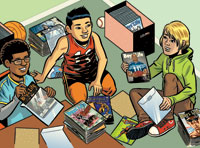How to start a collection of magazines
 It’s easy to collect photos of your favorite athletes or celebrities. And you don’t even need a camera to do it. Some come right to you in the mail each month. (Like mountain biker Adam Craig on the cover of September’s Boys’ Life or first baseman Ryan Howard on last April’s cover.)
It’s easy to collect photos of your favorite athletes or celebrities. And you don’t even need a camera to do it. Some come right to you in the mail each month. (Like mountain biker Adam Craig on the cover of September’s Boys’ Life or first baseman Ryan Howard on last April’s cover.)
Collect magazine covers. The photos are great, the magazines are fun to read and finding them can sometimes be like a treasure hunt.
Before you start to build your collection, decide what to collect. There are hundreds of magazines published every year, and many thousands more exist from years gone by. (Guess how many issues of Boys’ Life — more than 1,100 and counting!) But that’s one of the best things about this collection: You choose what to collect, and you’ve got lots to choose from. We’ll use sports stars as an example, but you could choose anything. Canoeing, hiking, national parks, cars — anything goes.
| KEEP IT CLEAN
Collectible magazines are graded according to condition. Generally, the better the condition of a particular issue, the higher the value. Always check the condition before you commit to buy a collectible. MINT: A magazine graded M will have no water stains, wrinkles or tears; rusty staples or an unattached cover; creased spine or penmarks; mailing label on the cover; pictures cut out of the inside. In short, it’s a perfect magazine. NEAR MINT: An NM issue can have a few small stress lines on the spine, a very minor corner chip or crease and tiny color flecks or bindery tear, but no other defects are allowed. VERY FINE: To be VF, a copy might have the first sign of a lack of complete flatness and some cover wear or slight wear at the corners or along the edges. The spine may have a few more transverse stress lines. Pages may be yellowed or tanned. FINE: An F copy shows minor wear, is relatively flat and has corner dings but no major creasing or serious defects. There may be noticeable surface wear and accumulation of minor defects along the spine and edges. VERY GOOD: The average used issue is VG. It shows reading wear, some discoloration and soiling. A small piece may be missing from a corner, but no chunks from the cover are allowed. Cover and interior pages may have minor tears or folds. Cover may be loose, but not completely detached. GOOD: All pages and covers of a G issue are present, though bits may be missing (nothing that would make any words unreadable). Cover may be detached. This is the lowest grade accepted by many collectors. |
WHAT’S YOUR FANCY?
For most, it’s the cover of the magazine that makes it collectible. Most people collect their favorite player. But there are many other themes for collections, such as:
• Team: Collect magazines with players from your favorite team on the cover.
• Sport: If your favorite sport is one of the “Big Four” — baseball, football, basketball or hockey — this might become just too big. But if you really like skateboarding or surfing or golf or the Olympics, some terrific magazines are just waiting to become part of your collection.
• Title: Some magazines continue for decades. Others are around for only a few issues. It can be a real challenge to put together complete runs of a particular magazine.
• First issue: The premiere issue of any magazine is usually more difficult to find and therefore more desirable for collectors. However, it can also be much more expensive.
• Birthday: Here’s a really personalized theme for a collection. Collect magazines that were “born” the same day, month or year as you.
THE THRILL OF THE HUNT
Bookstores will carry current magazines, but you’ll have to pay full cover price. In a year or so, you might find those same magazines much cheaper at a used-book store. You can also subscribe to many magazines for less than half the cover price.
Older, out-of-print magazines are harder to find. (But maybe not too hard: Ask your parents if there are any old magazines squirreled away in the garage or attic.) Yard sales and flea markets are excellent sources. And don’t forget to check out Internet auction sites like eBay, or do a search on the term “collectible magazines.”
Mail-order dealers are another place to findcopies. You’ll probably have to pay more, especially for older, hard-to-find magazines. But it’s definitely more fun to search through a dusty box under a table at a flea market or in an attic and find that copy of a magazine you’ve been wanting for a while.
I have rangerrick!
gull139 you have one from wen i was born!
thats cool i am gonna start one
thanks, i want my birthday issue.
I resently have about14
I got TWO new Boys’ Life magazines: One for Christmas, one at a book store!
i’ve got some comic books dating all the way to 1954.
i collect national geographic and boyslife
i want all the issue of boy’s life and my birth issue
I have an issue of boys life dated February 1926
I have all the boys life issues from December 2004-January 2009.